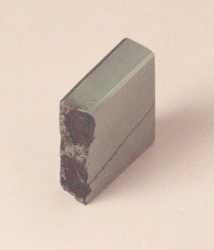Iron, IIAB, hexahedriteOne of the main types of iron meteorites composed almost entirely of kamacite and named for its cubic (hexahedral) cleavage of α-Fe-Ni crystals. Upon etching, hexahedrites do not display a Widmanstätten pattern, but do often exhibit fine, parallel lines called Neumann lines for their discoverer, Franz Neumann, who first studied Click on Term to Read More
(Compositionally related to group IIG)

Found 1971, recognized 1990
26° 6′ N., 106° 58′ W. This dish-shaped 58.63 kg meteoriteWork in progress. A solid natural object reaching a planet’s surface from interplanetary space. Solid portion of a meteoroid that survives its fall to Earth, or some other body. Meteorites are classified as stony meteorites, iron meteorites, and stony-iron meteorites. These groups are further divided according to their mineralogy and Click on Term to Read More was found beside a mountain road 0.5 km south of Guadalupe y Calvo, Mexico. The meteorite was used as a dog bowl on a ranch in Chihuahua, Mexico until it was recognized as meteoritic and traded for a new pickup truck. Having low nickel contents of 4.5%–6.5%, hexahedrites consist of large cubic crystals of kamaciteMore common than taenite, both taenite and kamacite are Ni-Fe alloys found in iron meteorites. Kamacite, α-(Fe,Ni), contains 4-7.5 wt% Ni, and forms large body-centered cubic crystals that appear like broad bands or beam-like structures on the etched surface of a meteorite; its name is derived from the Greek word Click on Term to Read More. Upon etching, this meteorite class exhibits shock-induced, parallel twinning planes named ‘Neumann’ lines, but exhibits no Thomson (Widmanstätten) structure. Previously, a division of the similar magmatic irons into the IIA and IIB groups was made based on this structure, but because there is no compositional hiatus between these groups, such a division is considered arbitrary and is no longer recognized (Wasson et al., 2007).
A simple
fractional crystallizationA crystallization process in which minerals crystallizing from a magma are isolated from contact with the liquid. It is a key process in the formation of igneous rocks during the process of magmatic differentiation. Also known as crystal fractionation. Click on Term to Read More model for the IIAB group gives an estimate for a high initial S and P content in the molten
coreIn the context of planetary formation, the core is the central region of a large differentiated asteroid, planet or moon and made up of denser materials than the surrounding mantle and crust. For example, the cores of the Earth, the terrestrial planets and differentiated asteroids are rich in metallic iron-nickel. Click on Term to Read More. These high abundances are in accord with high abundances for other
volatile elementsChemical elements that condense (or volatilize) at relatively low temperatures. The opposite of volatile is refractory. Volatile elements can be divided into moderately volatile (Tc = 1230–640 K) and highly volatile (Tc < 640 K). The moderately volatile lithophile elements are: Mn, P, Na, B ,Rb, K, F, Zn. The moderately Click on Term to Read More, and is consistent with the trends observed for Ga, Ge, and Ir
vs. AuThe astronomical unit for length is described as the "mean" distance (average of aphelion and perihelion distances) between the Earth and the Sun. Though most references state the value for 1 AU to be approximately 150 million kilometers, the currently accepted precise value for the AU is 149,597,870.66 km. The Click on Term to Read More (N. Chabot, 2004). This
fractionationConcentration or separation of one mineral, element, or isotope from an initially homogeneous system. Fractionation can occur as a mass-dependent or mass-independent process. Click on Term to Read More model also indicates that the upper core material, which was derived from the late-crystallizing, S-rich residual liquid, is not represented in our collections. Rather, IIAB irons sample the lower P-rich core region formed after no more than 48%
crystallizationPhysical or chemical process or action that results in the formation of regularly-shaped, -sized, and -patterned solid forms known as crystals. Click on Term to Read More of the parental
magmaMolten silicate (rock) beneath the surface of a planetary body or moon. When it reaches the surface, magma is called lava. Click on Term to Read More.
In the fractional crystallization sequence of the IIAB parental magma, Guadalupe y Calvo represents the earliest phase, forming after only 2% crystallization (Sikhote Alin is among the latest, forming at the 48% crystallization stage). It has been proposed by Wasson and Choe (2009) that formation of IIG irons occurred inside isolated cavities which remained after crystallization of a more evolved IIAB magma. The IIG irons eventually crystallized in a P-rich region of the lower layer of the IIAB core, while an
immiscibleThe property of liquids that are mutually insoluble (won't mix together) such as oil and water or metallic and silicate melts. Click on Term to Read More and buoyant S-rich magma collected in the upper regions of the magma chamber. The Ge-isotopic data obtained by Luais
et al. (2014) support the formation history proposed by Wasson and Choe (2009) (see the
Tombigbee River page for further details). Material from the upper, nonmetal-rich core region was derived from the more highly evolved magmas is not present in our collections, and it is presumed that it does not survive the journey to Earth (Wasson
et al., 2007). The specimen of Guadalupe y Calvo shown above is a 14.4 g partial slice.







